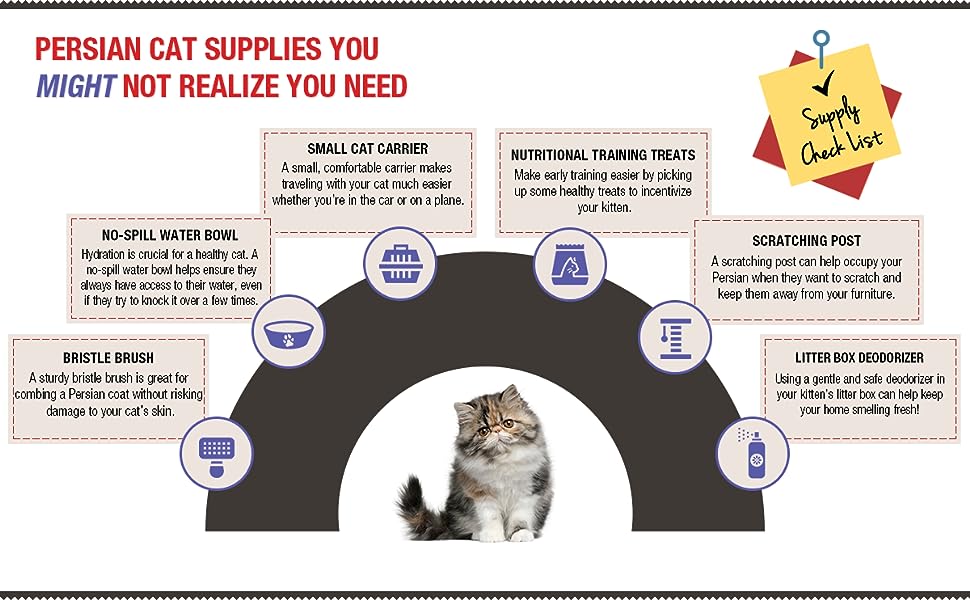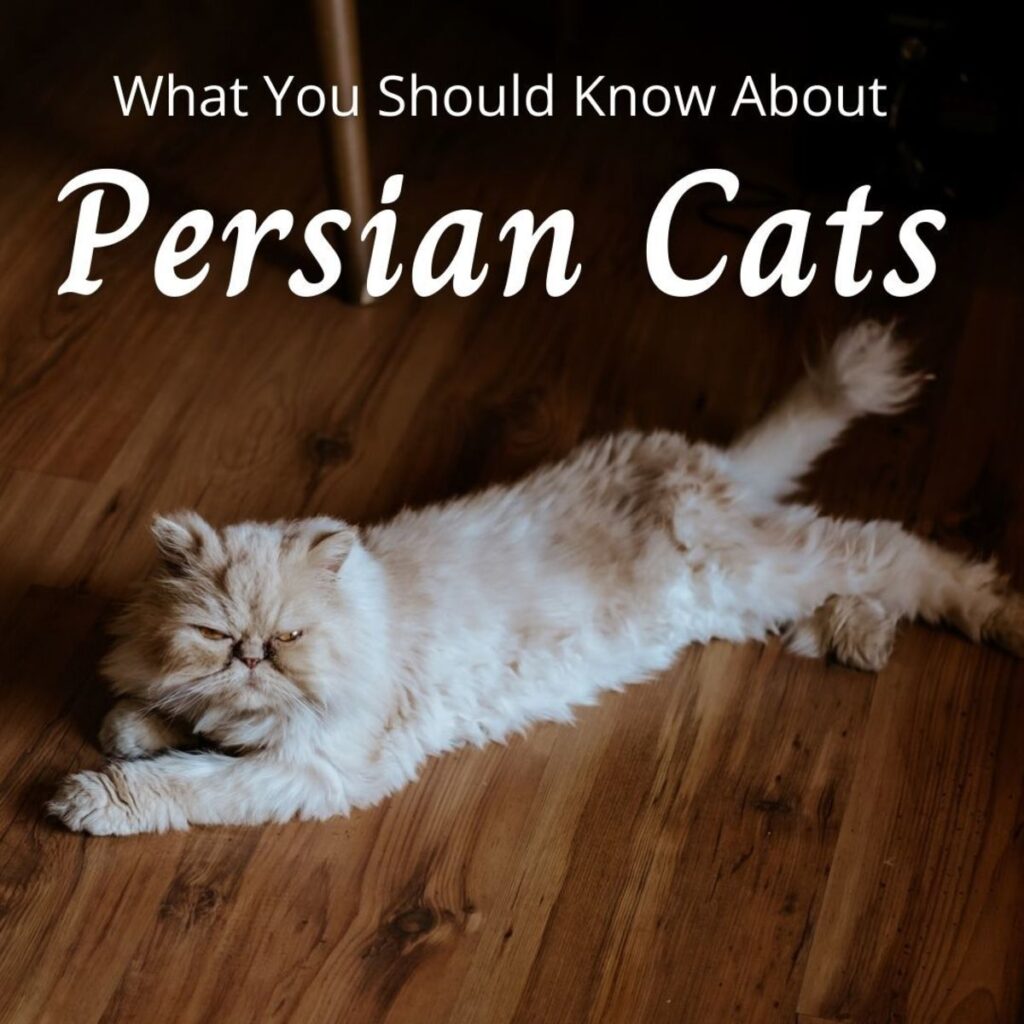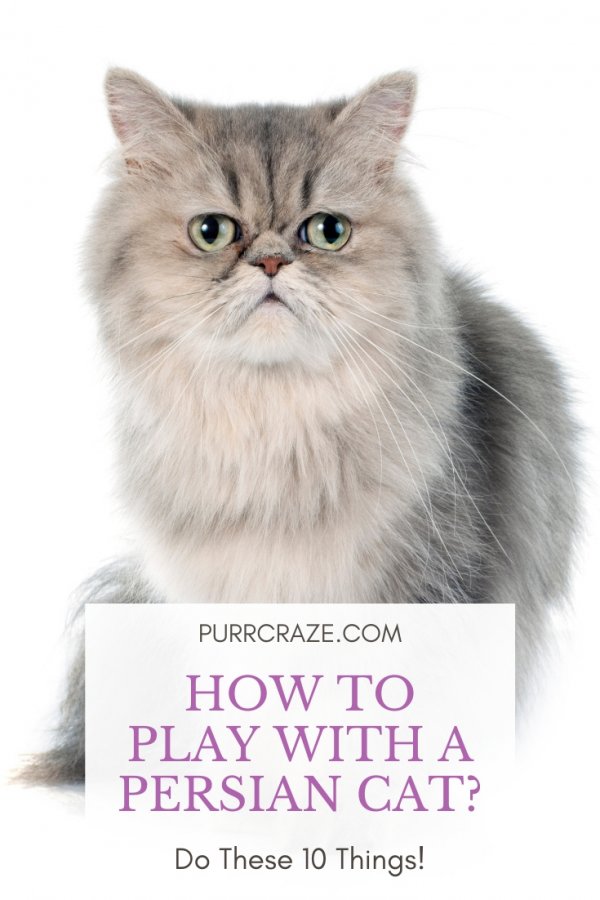Are you excited about bringing a new Persian cat into your home? If so, it’s important to make sure that your house is ready to welcome your furry friend. In this article, we will provide you with essential tips and guidelines on how to prepare your home for a new Persian cat. From creating a safe and comfortable environment to stocking up on supplies, we’ve got you covered. So, let’s get started and make sure your new feline companion feels right at home in no time.

Setting Up a Safe Environment
As a new Persian cat owner, it’s important to create a safe environment for your furry friend. Here are some essential steps you can take to ensure your cat’s safety and well-being.
Creating a Quiet Space
Persian cats are known for their calm and gentle demeanor, and they thrive in a peaceful environment. It’s important to set up a quiet space where your cat can retreat to when they need some alone time. This can be a specific room or a cozy corner in your home, equipped with a comfortable bed and a few toys to keep them entertained.
Securing Windows and Doors
To prevent any accidents or injuries, it’s crucial to secure all windows and doors in your home. Make sure that screens are securely in place and that there are no gaps or openings where your cat could escape or get stuck. Additionally, consider installing window guards or safety nets if you live in a high-rise building or have windows that open wide.
Removing Toxic Plants
Some plants can be toxic to cats, and it’s important to remove any potentially dangerous ones from your home. Persian cats are curious by nature and may nibble on plants, so it’s better to be safe than sorry. Research which plants are toxic to cats and either remove them completely or place them in areas your cat cannot access.
Covering Electrical Cords
Electrical cords can pose a serious risk to cats if they chew on them. To prevent any accidents, make sure to cover or hide electrical cords, especially those that are easily accessible. You can use cord covers or even tape them to the wall to keep them out of your cat’s reach.
Choosing Safe Cleaning Products
When cleaning your home, it’s important to choose safe and non-toxic products, as Persian cats are sensitive to chemicals. Avoid using products that contain harsh chemicals or strong odors, as they can cause respiratory issues or skin irritations. Opt for pet-friendly and environmentally-friendly cleaning products instead.
Providing Basic Necessities
Aside from creating a safe environment, it’s crucial to provide your Persian cat with their basic necessities. Here are some essential items you should consider when welcoming a Persian cat into your home.
Selecting the Right Litter Box
Choosing the right litter box is essential for your cat’s comfort and hygiene. Persian cats have long fur, so it’s best to opt for a litter box with high sides to prevent litter from being kicked out. Additionally, consider choosing a litter box with a hood or cover to provide privacy for your cat.
Choosing the Appropriate Litter
There are various types of litter available, so it’s important to choose one that suits your Persian cat’s needs. Avoid litters with strong scents, as Persian cats are sensitive to odors. Opt for unscented litter that clumps well, making it easier to clean and maintain hygiene.
Picking a Comfortable Bed
Persian cats love to lounge and nap, so providing them with a comfortable bed is essential. Look for a bed that is soft, plush, and provides adequate support. Consider purchasing a bed with a raised edge or sides to offer a sense of security and coziness.
Providing Food and Water Dishes
Invest in high-quality food and water dishes that are suitable for Persian cats. Ceramic or stainless steel dishes are preferable, as they are durable, easy to clean, and resistant to bacteria growth. Avoid using plastic dishes, as they can harbor bacteria and may cause allergic reactions.
Selecting Suitable Toys
Keeping your Persian cat entertained and mentally stimulated is important for their overall well-being. Choose toys that are specifically designed for cats, such as interactive toys, catnip-filled toys, or puzzle toys. Avoid toys with small parts that could be a choking hazard, and make sure to rotate the toys regularly to keep things interesting.
Understanding Persian Cat Grooming
Persian cats have long, luxurious coats that require regular grooming to keep them looking their best. Here are some important grooming tasks and tips to keep in mind.
Brushing and Combing Hair
Regular brushing is essential to prevent matting and keep your Persian cat’s coat in good condition. Use a wide-toothed comb or a brush specifically designed for long-haired cats. Start by gently combing the fur from the base, working your way up to remove any tangles or mats. Aim to brush your Persian cat’s coat at least once a day to keep it free from knots.
Trimming Nails
Keeping your Persian cat’s nails trimmed is important for their comfort and to prevent any scratches. Use a pair of cat nail clippers or guillotine-style clippers specifically designed for cats. Be cautious and only trim the very tip of the nail to avoid cutting into the quick, which can cause bleeding and pain.
Cleaning Ears
Persian cats are prone to ear infections, so it’s important to regularly clean their ears. Use a cat-specific ear cleaner and cotton balls to gently wipe away any dirt or debris from the ear canal. Avoid using cotton swabs, as they can push debris further into the ear and potentially damage the ear canal.
Preventing Tear Stains
Persian cats are known for their beautiful, expressive eyes, but they can be prone to tear stains. To prevent tear stains, gently wipe your cat’s eyes with a damp cloth or specialized eye wipes made for cats. Be careful not to touch the eye directly and avoid using any harsh products near the eye area.
Bathing Your Persian Cat
Bathing a Persian cat should be done occasionally, as they are naturally clean animals and their long fur can be challenging to dry properly. Use a cat-specific shampoo and gently massage it into their coat, avoiding their face and eyes. Rinse thoroughly to remove all the shampoo, and carefully dry your cat’s fur using a towel or a low-heat blow dryer.
Establishing a Feeding Routine
Establishing a consistent feeding routine is important for your Persian cat’s health and well-being. Here are some factors to consider when it comes to feeding your furry friend.
Selecting the Right Food
Choosing the right food for your Persian cat is crucial to ensure they receive the proper nutrition. Opt for high-quality cat food that is specifically formulated for the needs of Persian cats. Look for options that contain a balanced blend of protein, fat, and essential vitamins and minerals.
Determining Portion Sizes
Portion control is important to maintain a healthy weight for your Persian cat. Follow the feeding guidelines provided on the cat food packaging and adjust accordingly based on your cat’s age, weight, and activity level. Avoid overfeeding, as obesity can lead to various health issues.
Choosing Meal Frequency
Most Persian cats do well with two meals a day, but it’s important to consider your cat’s individual needs. Consult with your veterinarian to determine the best meal frequency for your cat based on their age, metabolism, and any specific dietary requirements.
Introducing New Foods
If you decide to switch your Persian cat’s food or introduce new foods into their diet, it’s important to do it gradually. Sudden changes in diet can lead to digestive upset. Start by mixing a small amount of the new food with their current food, gradually increasing the proportion over the course of a week.
Monitoring Weight and Health
Regularly monitor your Persian cat’s weight and overall health to ensure they are thriving. Keep an eye out for any changes in appetite, weight loss or gain, or any other signs of illness. If you have any concerns, consult with your veterinarian for proper guidance and care.

Creating a Playful Environment
Playtime is not only fun for your Persian cat but also essential for their physical and mental well-being. Here are some tips for creating an engaging and playful environment for your furry friend.
Providing Scratching Posts
Persian cats have natural scratching instincts, so it’s important to provide them with appropriate outlets for their scratching needs. Invest in a sturdy scratching post or multiple scratching surfaces throughout your home. Make sure they are tall enough for your cat to stretch and sturdy enough to support their weight.
Offering Interactive Toys
Interactive toys can provide mental stimulation and keep your Persian cat entertained for hours. Consider toys that mimic prey movements or toys with hidden treats to keep them engaged. Rotate the toys regularly to keep your cat’s interest levels high.
Creating Vertical Spaces
Persian cats love to climb and explore their surroundings. Provide vertical spaces such as cat trees, shelves, or window perches where your cat can safely climb and observe their environment. This will not only satisfy their natural instincts but also provide mental stimulation.
Rotating Toys
To prevent boredom and keep playtime exciting, it’s important to rotate your Persian cat’s toys regularly. Put away some toys and introduce new ones periodically to keep them engaged and curious. This will prevent the toys from becoming repetitive and less interesting over time.
Engaging in Playtime
Spend quality time engaging in play with your Persian cat to strengthen your bond and provide exercise. Use interactive toys that you can control, such as feathers on strings, laser pointers, or wand toys. Experiment with different types of play to find what your cat enjoys the most.
Introducing Your Persian Cat to Other Pets
Introducing a Persian cat to other pets in your household requires patience and a gradual process. Here are some important steps to follow when introducing your Persian cat to other pets.
Gradual Introduction Process
Start by introducing your Persian cat to the other pets in a controlled environment. Keep them separated initially and allow them to become familiar with each other’s scent by swapping bedding or toys. Gradually increase their exposure to each other by supervised visits in neutral territories.
Supervising Initial Interactions
Once your Persian cat and other pets have become somewhat familiar with each other’s presence, you can start supervised interactions. Make sure the introductions are positive and stress-free by using treats, rewards, and playtime. Keep interactions short initially and gradually increase the duration as they become more comfortable.
Creating Separate Feeding Areas
To avoid any conflicts during mealtime, it’s important to provide separate feeding areas for your Persian cat and other pets. This will prevent competition and potential aggression. Each pet should have their own designated feeding area where they can eat in peace.
Providing Individual Attention
While your Persian cat adjusts to their new environment and gets to know the other pets, make sure to provide individual attention and quality time with each pet. This will help prevent jealousy and ensure that all your pets feel loved and valued.
Seeking Professional Help if Needed
Sometimes, introducing a Persian cat to other pets can be challenging, especially if there are conflicts or aggression. If you are struggling with the introduction process, it’s important to seek professional help from a certified animal behaviorist or a veterinarian.

Promoting Mental Stimulation
Mental stimulation is just as important as physical exercise for your Persian cat’s overall well-being. Here are some ways to promote mental stimulation for your furry friend.
Implementing Puzzle Toys
Puzzle toys are a great way to engage your Persian cat’s mind and provide mental stimulation. These toys require problem-solving skills and can keep your cat entertained for hours. Fill them with treats or kibble to make the experience rewarding for your cat.
Using Treat-Dispensing Toys
Treat-dispensing toys are another excellent tool to keep your Persian cat mentally stimulated. These toys require your cat to manipulate the toy to release the treats. It not only challenges their mind but also provides a fun and engaging way to enjoy treats.
Engaging in Clicker Training
Clicker training is a positive reinforcement method that can be used to teach your Persian cat new tricks or commands. It’s a fun and interactive way to mentally stimulate your cat while reinforcing good behavior. Use small, tasty treats as rewards and gradually increase the difficulty level of the training.
Teaching Simple Commands
Persian cats are intelligent and can learn simple commands with patient training. Start with basic commands such as “sit” or “come” using positive reinforcement techniques. Keep training sessions short and rewarding to keep your cat engaged and interested.
Engaging in Interactive Play
Interactive play sessions are not only physically stimulating but also mentally engaging for your Persian cat. Use interactive toys and engage in playtime by mimicking prey movements or encouraging your cat to chase and pounce. This helps satisfy their hunting instincts and provides a mentally stimulating activity.
Understanding Persian Cat Communication
Understanding your Persian cat’s communication cues can strengthen your bond and help you meet their needs more effectively. Here are some communication cues to be aware of.
Recognizing Body Language
Pay close attention to your Persian cat’s body language, as it can provide valuable insights into their emotions and needs. Watch for signs of contentment, such as relaxed body posture and gentle purring, as well as signs of stress or discomfort, such as a hunched back, flattened ears, or swishing tail.
Understanding Different Sounds
Persian cats can use various vocalizations to communicate with you. Listen for different sounds such as meowing, chirping, purring, or hissing. Each sound has its own meaning, and over time, you’ll be able to decipher what your cat is trying to convey through their vocalizations.
Interpreting Tail Movements
A cat’s tail can be very expressive and can convey their mood or intentions. Pay attention to your Persian cat’s tail movements. A relaxed and gently swaying tail typically indicates contentment, while an erect and puffed tail can indicate fear or aggression. A flicking or twitching tail may indicate excitement or anticipation.
Discovering Facial Expressions
Although subtle, Persian cats can display various facial expressions that can provide clues about their emotions. Look for relaxed eyes, slow blinking, and soft ears, which typically indicate contentment. Wider eyes, dilated pupils, or flattened ears can indicate fear or anxiety.
Responding to Communication Cues
When your Persian cat communicates with you, it’s essential to respond appropriately to their needs. If your cat approaches you with purring and rubbing against your leg, they may be seeking affection or attention. If they hiss or growl, it’s best to give them space and respect their boundaries.

Establishing a Vet Care Routine
Regular veterinary care is crucial to keeping your Persian cat healthy and happy. Here are some steps to establish a vet care routine for your furry friend.
Finding a Trusted Veterinarian
Start by finding a veterinarian who specializes in feline care and has experience with Persian cats. Ask for recommendations from other cat owners or do some research online. It’s important to find a vet that you trust and feel comfortable with.
Scheduling Regular Check-ups
Regular check-ups are essential to monitor your Persian cat’s health and catch any potential health issues early on. Follow your vet’s recommendations for check-up frequency, which may vary depending on your cat’s age and overall health.
Vaccination and Deworming
Make sure your Persian cat is up to date on all vaccinations and deworming treatments. Vaccines help protect your cat against infectious diseases, while deworming treatments help prevent and treat internal parasites. Consult with your vet to develop a vaccination and deworming schedule that suits your cat’s needs.
Preventive Care Measures
In addition to vaccinations and deworming, discuss preventive care measures with your vet. This may include flea and tick prevention, heartworm prevention, and dental care. Regular preventive care helps maintain your Persian cat’s overall health and prevents potential health issues.
Recognizing Common Health Issues
Persian cats are prone to certain health issues, such as respiratory problems, urinary tract issues, and eye problems. Familiarize yourself with the common health issues that Persian cats may face and learn how to recognize any potential symptoms. If you notice any concerning signs, consult with your veterinarian.
Preparing for Traveling with Your Persian Cat
If you need to travel with your Persian cat, whether it’s a quick trip to the vet or a longer journey, it’s important to be prepared. Here are some tips for traveling with your furry friend.
Getting Your Cat Used to Car Rides
Not all cats enjoy car rides, so it’s important to get your Persian cat accustomed to traveling in a car. Start by taking short trips in a carrier, gradually increasing the duration. Offer treats and reassurance to make the experience as positive as possible.
Using a Secure Carrier
Invest in a secure and sturdy carrier specifically designed for cats. Make sure it is well-ventilated, easy to clean, and provides enough room for your Persian cat to move comfortably. Familiarize your cat with the carrier by leaving it open in your home and encouraging them to explore and nap inside.
Packing Essential Travel Items
When traveling with your Persian cat, make sure to pack all the essential items they will need. This includes food, water, a leash, a collar with ID tags, a litter box, litter, grooming supplies, any necessary medications, and their favorite toys or blankets. It’s also a good idea to have a copy of their medical records in case of emergencies.
Considering Motion Sickness Remedies
Some cats may experience motion sickness during car rides. Consult with your veterinarian about possible remedies or medications that can help alleviate any discomfort. Additionally, avoid feeding your cat a large meal before traveling and provide fresh air and a comfortable environment inside the car.
Seeking Professional Advice for Long Trips
If you are planning a long trip with your Persian cat or traveling by air, it’s important to seek professional advice. Consult with your veterinarian or a pet travel specialist to ensure that you have all the necessary documentation, understand any travel restrictions, and have a plan in place to keep your cat safe and comfortable throughout the journey.
By following these guidelines, you can create a safe and enriching environment for your Persian cat. Remember to always prioritize their health, happiness, and well-being, and enjoy the wonderful companionship that these majestic and gentle cats provide.

Question and Answer Section
-
Q: How do I create a quiet space for my Persian cat? A: You can designate a specific room or corner in your home with a comfortable bed and a few toys where your cat can retreat to for peace and quiet.
-
Q: Are all plants toxic to Persian cats? A: Not all plants are toxic to cats, but there are some that can be harmful if ingested. It’s important to research and remove any potentially dangerous plants from your home.
-
Q: Can I use any cleaning products around my Persian cat? A: It’s best to use pet-friendly and non-toxic cleaning products, as Persian cats are sensitive to chemicals. Avoid products with harsh chemicals or strong odors.
-
Q: How often should I brush my Persian cat’s hair? A: It’s recommended to brush your Persian cat’s coat at least once a day to prevent matting and keep their fur in good condition.
-
Q: How do I choose the right litter box for my Persian cat? A: Opt for a litter box with high sides to prevent litter from being kicked out. Consider a litter box with a hood or cover to provide privacy for your cat.
-
Q: How often should I trim my Persian cat’s nails? A: Regular nail trims are important to prevent scratches. Trim the very tip of the nail, being cautious not to cut into the quick.
-
Q: How do I clean my Persian cat’s ears? A: Use a cat-specific ear cleaner and cotton balls to gently wipe away any dirt or debris from the ear canal. Avoid using cotton swabs.
-
Q: What can I do to prevent tear stains in my Persian cat? A: Gently wipe your cat’s eyes with a damp cloth or specialized eye wipes made for cats to prevent tear stains. Avoid using harsh products near the eye area.
-
Q: How often should I bathe my Persian cat? A: Bathing should be done occasionally, as Persian cats are naturally clean. Use a cat-specific shampoo and gently dry their fur afterward.
-
Q: How do I introduce my Persian cat to other pets in my home? A: Start with a gradual and controlled introduction process, allowing the pets to become familiar with each other’s scent before progressing to supervised interactions.
